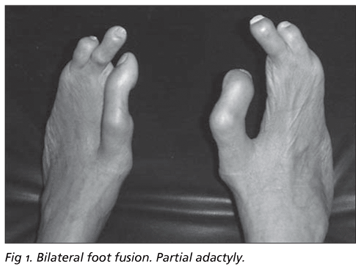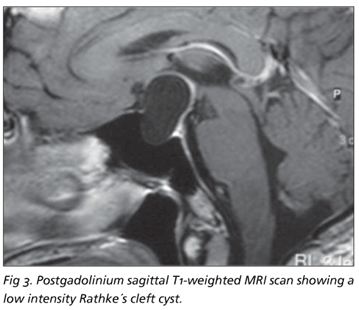Abstracts
A 53 year-old woman presented a recurrent bifrontal headache of 2 years duration and bilateral progressive visual disturbance. The clinical and neurological examination showed a bilateral feet adactyly and bitemporal hemianopsia. The brain MRI demonstrated a Rathke's cleft cyst. The patient was operated by a transnasal endoscopic approach. It seems that this unusual association has never been described before.
adactyly; endoscopic; pituitary surgery; pituitary tumor; rathke's cleft cyst; transnasal approach
Mulher de 53 anos com história recorrente de cefaléia com duração de 2 anos bilateral e progressiva, acompanhada de distúrbios visuais. O exame clinico e neurológico mostrou uma adactilia dos pés e hemianopsia bitemporal. A ressonância nuclear magnética cerebral mostrou um cisto de Rathke. A paciente foi operada por via transnasal endoscópica. Aparentemente esta é a primeira vez que esta associação é descrita na literatura.
adactilia; endoscopia; cirurgia hipofisária; cisto de rathke; tumor de hipófise; via transnasal
SCIENTIFIC NOTES
Rathke's cleft cyst and partial feet adactyly: an unusual association
Cisto de Rathke e adactilia parcial dos pés: uma associação rara
Jackson A. GondimI; Michele SchopsI; João Paulo CavalcanteI; Erica GomesII
INeuroendocrinological Department, General Hospital of Fortaleza, Fortaleza CE, Brazil
IIOtolaryngology Department, General Hospital of Fortaleza, Fortaleza CE, Brazil
ABSTRACT
A 53 year-old woman presented a recurrent bifrontal headache of 2 years duration and bilateral progressive visual disturbance. The clinical and neurological examination showed a bilateral feet adactyly and bitemporal hemianopsia. The brain MRI demonstrated a Rathke's cleft cyst. The patient was operated by a transnasal endoscopic approach. It seems that this unusual association has never been described before.
Key words: adactyly, endoscopic, pituitary surgery, pituitary tumor, rathke's cleft cyst, transnasal approach.
RESUMO
Mulher de 53 anos com história recorrente de cefaléia com duração de 2 anos bilateral e progressiva, acompanhada de distúrbios visuais. O exame clinico e neurológico mostrou uma adactilia dos pés e hemianopsia bitemporal. A ressonância nuclear magnética cerebral mostrou um cisto de Rathke. A paciente foi operada por via transnasal endoscópica. Aparentemente esta é a primeira vez que esta associação é descrita na literatura.
Palavras-chave: adactilia, endoscopia, cirurgia hipofisária, cisto de rathke, tumor de hipófise, via transnasal.
Rathke'S cleft cyst (RCC) is an epithelial cell-lied cyst of the pituitary believed to derive from remnants of Rathke's pouch, a dorsal invagination of the stomodeal ectoderm1. Partial adactyly is an autosomal congenital anomaly of the hand or foot, market by persistence of the webbing between adjacent digitis.
We report an unusual association of these two entities in a 53 years old woman.
CASE
A 53-years-old woman with an unremarkable family history, issued of not consanguineous parents, presented a recurrent bifrontal headache of 2 years duration and bilateral progressive visual disturbance. Endocrinological evaluation included measurement of baseline levels of ACTH, cortisol, TSH, free T3, free T4, GH, PRL, LH, FSH, and oestradiol. Dynamic stimulation test were done with insulin (0.1 U/kg), TRH (500 µg), GnRH (100 µg) CRH (100 µg) and GHRH (100 µg). The patient had no primary disturbance of thyroid, adrenal and gonadal functions. Her physical examination showed bilateral partial adactyly of the feet (Fig 1) and the ophthalmologic examinations showed bitemporal hemianopsia. Chromosomes were apparently normal. Neuroimaging (MRI) revealed a Rathke's cleft cyst (20x15x14 mm) with intra and supra sellar components (Figs 2 and 3). The patient underwent a transnasal endoscopic surgery with drainage and resection of the cyst wall (Figs 4 and 5). The last examination of the patient two years after neurological surgery showed a complete recuperation of the hemianopsia, and the orthopedic surgery service has done a partial corrections of her feet adactyly.
DISCUSSION
Rathke's cleft cysts are a benign epthelium-lined intrasellar cysts believed to originate from remnants of the Rathke pouch, a dorsal invagination of the stomodeal ectoderm1. RCCs commonly have a round, ovoid or dumbbell shape and rarely cause symptoms. They have been reported in 2-26% of pituitary glands studied at autopsy2 or in as many as 33% of cases3. No racial predilections recognized and there is a male-to-female ratio of 1:2. The patients age at presentation ranges from 4-73 years (mean age, 38 years). The highest frequency is in those aged 50-60 years3. On MRI RCC usually does not exhibit destruction or enlargement of the sella turcica4, but there is in our case. Intracystic nodules, that are waxy nodules, if present, show characteristically intensity on MRI5. RCCs are almost always homogeneous in MR intensity, except for waxy nodules, whereas other lesions such as cystic craniopharyngioma and hemorrhagic adenomas are less frequently homogeneous6. A high T1-WI intensity has been interpreted to indicate a high content of protein and mucocopolysaccharide and, rarely are hemorrhage7. The cystic content of high and isointensity RCCs on T1-WI is usually mucus with varying viscosity. By constrat, RCCs with low intensity on T1-WI usually contain CSF-like, transparent fluid, with low viscosity8.
Syndactyly (webbed toes or fingers) occurs in approximately one in 2,000 to 2,500 live births. There are various levels of syndactylization, from partial to complete. The most frequent site is between the second and thirds toes. Syndactyly is thought to be genetic, with an autosomal dominant pattern of inheritance. Cleft foot (lobster foot) is an anomaly in which a single cleft extends proximally into foot, sometimes even as far as midfoot. Generally one or more toes and parts of their metatarsals are absent, and often the tarsals are abnormal. Although the deformity varies in degree and type, the first and fifth toes usually are present. If a metatarsal is partially or completely absent, its respective toe is always absent too9. Recently some authors have connected cigarette smoking during pregnancy and an elevated risk of having a child with polydactyly, sindactyly, or adactyly. Differential diagnosis can be considered with: Apert syndrome (a rare autosomal dominant disorder characterized by craniosynostosis, craniofacial anomalies, and severe symmetrical syndactyly cutaneous and bony fusion of the hands and feet), Saethre-Chotzen syndrome (a relatively mid form of acrocephalosyndactyly with a variable pattern of craniofacial digital, and bone abnormalities), Pallister-Hall syndrome (central and postaxial polydactyly, hypothalamic hamartoma, bifid epiglottis, imperforate anus, renal abnormalities, pulmonary segmentation and inherited in an autosomal dominant pattern), Ellis-van Crevald syndrome (congenital heart defects, polydactyly, multiple frenula, and natal teeth), Smith Lemli-Opitz syndrome (polydactyly and various SNC anomalies), oral-facial-digital syndrome type VI (autosomal recessive polydactyly, tongue hamartoma, and cerebelar vermis hypoplasia), Kaufman-McKusick syndrome (autossomal recessive, hydrometrocolpos, polydactyly, and congenital heart defects), and Grieg cephalopolysyndactyly syndrome (autosomal dominat, polydactyly, and craniofacail abnormalities)10-13.
In conclusion, histological verification confirmed a Rathke's cleft cyst. Two years after surgery the patient is well and recuperated her vision. The association of Rathke's clef cyst and feet adactyly in a 53-year-old woman is an unusual association. In an exhaustive literature review it seems to be the first reported case. We propose that this patient may represent a clinically and perhaps genetically distinct entity, based on normal survival, normal intelligence, lack of endocrine dysfunction or facial anomalies, and no other structural malformation.
Acknowledgements The authors gratefully thank Cecilia Schops Oliveira for the English version of this paper.
Received 23 January 2007, received in final form 26 July 2007. Accepted 25 August 2007.
Dr. Jackson A. Gondim - Avenida Engenheiro Santana Junior 2977 / 1402 - 60175-650 Fortaleza CE - Brasil. E-mail: jackson.gondim@laposte.net
- 1. Gondim J, Schops M, Tella Jr OI. Transnasal endoscopic surgery of the sellar region: study of the first 100 cases. Arq Neuropsiquiatr 2003;61:836-841.
- 2. Voelker JL, Campbell RL, Muller J. Clinical radiographic and pathological features of symptomatic Rathke's cleft cyst. J Neurosurg 1991;74:534-544.
- 3. Daikokuya H, Inoue Y, Nemoto Y, Tashiro T, Shakudo M, Ohata K. Rathke's cleft cyst associated with hypophysitis: MRI. Neuroradiology 2000;42:532-534.
- 4. Oka H, Kawano N, Suwa T, Yada K, Kan S, Kameya T. Radiological study of symptomatic Rathke's cleft cysts. Neurosurgery 1994;35:632-637.
- 5. Nishioka H, Haraoka J, Izawa H, Ikeda Y. Magnetic ressonance imaging, clinical manifestation and Rathke's cleft cyst. Clinical Endocrinol 2006;64:184-188.
- 6. Ross DA, Norman D, Wilson CB. Radiologic characteristics and results of surgical management of Rathke's cysts in 43 patients. Neurosurgery 1992;30:173-179.
- 7. Ikeda H, Yoshimoto T. Clinicopathological study of Rathke's cleft cysts. Clinical Neuropathol 2002;21:82-91.
- 8. Saeki N, Sunami K, Sugaya Y, Yamaura A. A MRI finding and clinical manifestations in Rathke's cleft cyst. Acta Neurochirurgica (Wien) 1999:141,1055-1061.
- 9. Blauth W, Borisch NC. Cleft feet. Proposals for a new classification based on roentgenographic morphology. Clin Orthop Relat Res 1990:258:41-48.
- 10. Man LX, Chang B. Maternal cigarrete smoking during pregnancy increases the risk of having a child with a congenital digital anomaly. Plast Reconstr Surg 2006;117:301-308.
- 11. Kuo JS, Casey SO, Thompson LL. Truwit CL. Pallister-Hall syndrome: clinical and MR features. Am J Neuroradiol 1999;20:1839-1841.
- 12. Grebe TA, Clericuzio C. Autosomal dominant inheritance of hypothalamic hamartoma associated with polysyndactyly: heterogeneity or variable expressivity? Am J Med Genet 1996;66:129-137.
- 13. Johnston JJ, Olivos-Glander I, Killoran C, et al. Molecular and clinical analyses of Greig cephalopolysyndactyly and Pallister-Hall syndromes: robust phenotype prediction from the type and position of GLI3 mutations. Am J Hum Genet 2005;76:609-622.
Publication Dates
-
Publication in this collection
06 Dec 2007 -
Date of issue
Dec 2007
History
-
Received
23 Jan 2007 -
Reviewed
26 July 2007 -
Accepted
25 Aug 2007






